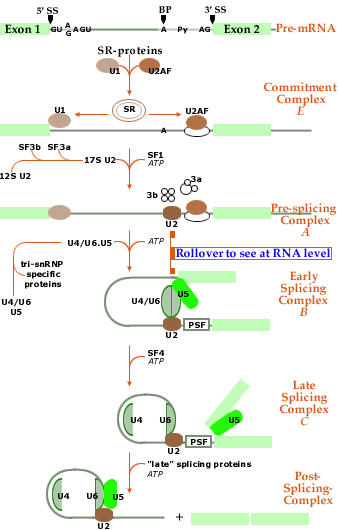Splicing - Detailed Scheme
Description of illustration
below
The
pre-mRNA is shown
at the top, having one
intron and two
flanking exons. Based on sequence comparisons of a
large number of introns and functional tests, we know
that short sequence motifs in the
pre-mRNA are
essential for splicing. These are located at the 5'
exon-intron border (5' Splice Site), at the 3'
exon-intron border (3' Splice Site) and at the so
called branch point (BP). Between the branch point
and the 3' SS, there is usually a sequence rich in
pyrimidines (which are cytidine and uracil) (Py).
Apart from these sequences, the remainder of the
intron sequence can
have any sequence or any length. Introns may be as
short as 50 bp or as long as 70-80 thousand bp. It
should be remembered that the
pre-mRNA is
associated with hnRNP proteins and not naked at any
time (these proteins are not shown in the figure
below).
Based on biochemical experiments, the
splicing factors
bind to the
pre-mRNA in a
specific order. Different complexes can be detected
(E to C). First, the U1 snRNP binds to the 5' SS,
partly by base pairing between the U1 snRNA component
and the conserved 5' SS sequence of the pre-mRNA. The
U1 snRNP is helped in the binding by special
proteins, called SR-proteins. SR-proteins can also
help another
splicing factor,
the U2AF protein complex, to bind to the
polypyrimidine region. Next, the U2 snRNP, together
with additional
splicing factors
(such as SF3b and SF3a and SF1) bind. The U2 snRNP
binds to the branch point, again by base pairing
between the
RNA component of
the snRNP and the pre-mRNA. PSF is a protein that
binds to the
pyrimidine rich
region. Subsequently, the U4, U6 and U5 snRNPs,
already bound to each other in a complex, the
U4/U6.U5 tri-snRNP, bind to the pre-mRNA. At this
stage the U1 snRNP seems to be removed. Energy, in
the form of ATP, is needed at several steps in this
scheme. It is not needed for the cleavage and
ligation of the
pre-mRNA, but presumably for conformational changes
in the spliceosome. Additional
splicing factors
such as SF4 bind, and the first transesterification
reaction takes place. After the second
transesterfication reaction, the two exons are
ligated together. The
intron is liberated
and rapidly degraded. The
splicing factors
are believed to be reused.
|
 |
Description of rollover
illustration:
In the spliceosome, numerous RNA-RNA, RNA-protein
and protein-protein interactions must occur. We
currently know most about the RNA-RNA
interactions, because it has been possible to
study these interactions both in vitro and in
vivo. The
RNA components
of the snRNP complexes interact with each other
and with the pre-mRNA. First, the U1 snRNA and
the U2 snRNA bind to the
pre-mRNA at the
5' SS and the branch point, respectively (top
figure). The U4 and U6 snRNAs bind to each other
before they associate with the
pre-mRNA
(middle figure). In the
spliceosome
(bottom figure), the U5 snRNA helps to hold the
two exons together. The U6 snRNA is believed to
play an important role, close to the reaction
center. It appears to replace the U1 snRNA at the
5' SS and also binds to the U2 snRNA. At this
stage the U4 snRNA no longer binds to the U6
snRNA. |
|